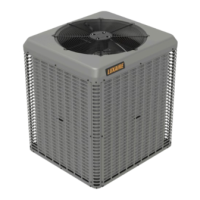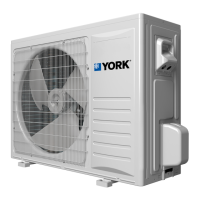JOHNSON CONTROLS
LOOP WATER SUPPLY AND PIPING
CONNECTIONS
The recommended circulating water supply for
heat pump systems is a closed
utilizing a cooling tower and boiler to maintain the
loop temperature within acceptable temperature
limits. Typically, the closed loop temperature is
maintained above 60 F and below 90 F. All units
function independently, either adding heat to
loop (cooling mode) or removing heat from the
loop (heating mode).
For applications where heating is required with
circulating water temperatures are below 35F
and contain antifreeze solution, please refer to
the Operations section under Freezestat
for information on configuring the unit.
When utilizing an open cooling tower
(evaporative type), chemical treatment is
mandatory to ensure that the loop water is free of
corrosive minerals. A secondary heat exchanger
between the open cooling towe
water loop may also be used. It is imperative that
all air is purged from the closed loop side to
prevent condenser fouling.
Dual acting water regulating valves should be
used when there is potential for low fluid flow
and/or, low fluid
temperature or high fluid
temperature conditions to exist. These water
regulating valve assemblies consist of a direct
acting valve parallel coupled to a reverse acting
valve. The direct acting valve opens in response
to an increase in discharge pressure d
cooling mode. The reverse acting valve opens in
response to a decrease in suction pressure
during heating mode.
SUPPLY/RETURN PIPING
Supply and return piping should be as large as
the unit connection sizes (larger on long pipe
runs). Never use flexible hoses of a smaller
inside diameter than that of the nominal water
pipe size. Both supply and return water lines will
sweat if subjecte
d to low water temperatures.
Insulate these lines as necessary to prevent
condensation damage.
LOOP WATER SUPPLY AND PIPING
The recommended circulating water supply for
heat pump systems is a closed
-water loop,
utilizing a cooling tower and boiler to maintain the
loop temperature within acceptable temperature
limits. Typically, the closed loop temperature is
maintained above 60 F and below 90 F. All units
function independently, either adding heat to
the
loop (cooling mode) or removing heat from the
For applications where heating is required with
circulating water temperatures are below 35F
and contain antifreeze solution, please refer to
the Operations section under Freezestat
Switch
for information on configuring the unit.
When utilizing an open cooling tower
(evaporative type), chemical treatment is
mandatory to ensure that the loop water is free of
corrosive minerals. A secondary heat exchanger
between the open cooling towe
r and the closed
water loop may also be used. It is imperative that
all air is purged from the closed loop side to
Dual acting water regulating valves should be
used when there is potential for low fluid flow
temperature or high fluid
temperature conditions to exist. These water
regulating valve assemblies consist of a direct
acting valve parallel coupled to a reverse acting
valve. The direct acting valve opens in response
to an increase in discharge pressure d
uring
cooling mode. The reverse acting valve opens in
response to a decrease in suction pressure
Supply and return piping should be as large as
the unit connection sizes (larger on long pipe
runs). Never use flexible hoses of a smaller
inside diameter than that of the nominal water
pipe size. Both supply and return water lines will
d to low water temperatures.
Insulate these lines as necessary to prevent
Flexible hoses should be used between the unit
and rigidly mounted piping to avoid vibration
transmission. Teflon tape thread sealant is
recommended. Do no
connections. Ball valves should be installed in
the supply and return lines for unit isolation and
water flow balancing. Before final connection to
the unit, the supply and return hoses should be
connected together and the piping sys
flushed to remove any dirt or foreign material.
Pressure and temperature ports are
recommended in both the supply and return lines
for system flow balancing. The water flow can be
accurately set by measuring the water
pressure drop through the u
versus pressure drop specification table for
application information.
Do not exceed the recommended
water flow rates. Damage due to
heat exchanger could occur.
Horizontal Units -
The 3/4 FPT drain connection
on the unit is NOT internally trapped. The cooling
coil compartment and drain pan are under
negative pressure when the blower is running;
therefore a P trap MUST be used in the drain
line.
It is recommended that a ¾ i
sloped (1/4 inch/foot) all the way to an open
drain. Each unit must be installed with its own
individual trap, and have the means to flush out
the condensate line if necessary. If it is not
possible to reach an open drain by gravity flow
pump kit, which is available as an accessory, can
be mounted close to the unit.
Vertical Units -
Each unit utilizes a flexible hose
inside the cabinet as a trapping loop. An external
P-trap is not necessary.
FORM 145.16-IOM2 (0611)
17
Flexible hoses should be used between the unit
and rigidly mounted piping to avoid vibration
transmission. Teflon tape thread sealant is
connections. Ball valves should be installed in
the supply and return lines for unit isolation and
water flow balancing. Before final connection to
the unit, the supply and return hoses should be
connected together and the piping sys
tem
flushed to remove any dirt or foreign material.
Pressure and temperature ports are
recommended in both the supply and return lines
for system flow balancing. The water flow can be
accurately set by measuring the water
-side
pressure drop through the u
nit. See the flow
versus pressure drop specification table for
Do not exceed the recommended
water flow rates. Damage due to
-to-refrigerant
heat exchanger could occur.
The 3/4 FPT drain connection
on the unit is NOT internally trapped. The cooling
coil compartment and drain pan are under
negative pressure when the blower is running;
therefore a P trap MUST be used in the drain
It is recommended that a ¾ i
nch drain line be
sloped (1/4 inch/foot) all the way to an open
drain. Each unit must be installed with its own
individual trap, and have the means to flush out
the condensate line if necessary. If it is not
possible to reach an open drain by gravity flow
, a
pump kit, which is available as an accessory, can
be mounted close to the unit.
Each unit utilizes a flexible hose
inside the cabinet as a trapping loop. An external

